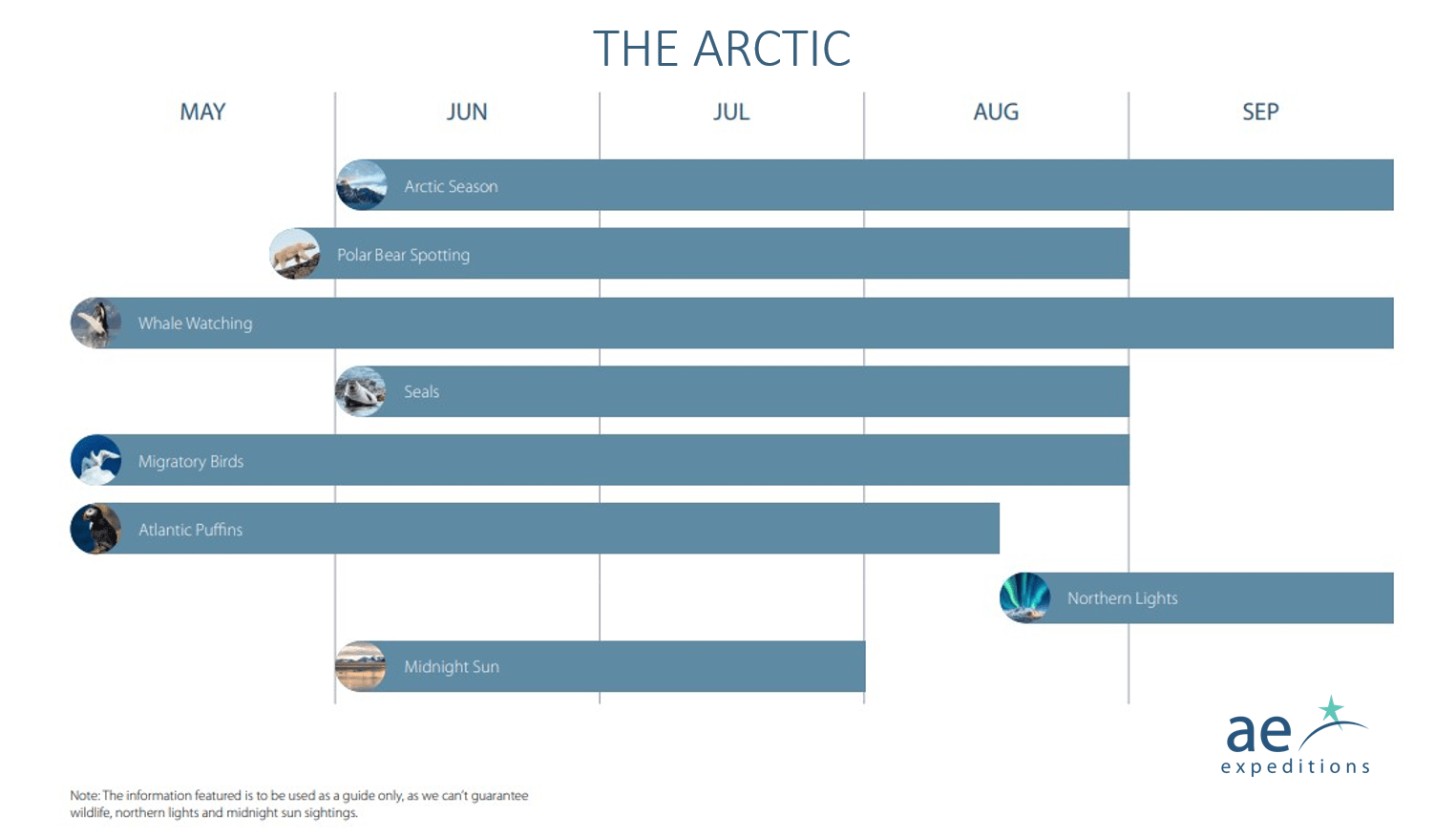
If you’re considering an Arctic Expedition trip and wondering what your wildlife spotting chances are, you’re in luck. Why? Because the Arctic is home to more wildlife than the Antarctic! The seasonal changes in the Arctic alter the landscape from blustery glacial winters to sunshine-drenched summers. As the ice thaws, the biodiversity of the tundra’s 2,000 species of vegetation becomes accessible, giving life to many fascinating species.
While you won’t be sighting Antarctic-native penguins on your Arctic expedition, there are plenty of animals to make up for it. Here are some wildlife to look out for when cruising this intrepid region of the world, and where you might hope to catch a glimpse of each iconic animal.
Polar Bears
Spotting the King of the Arctic is a major drawcard in choosing an Arctic expedition. While they may be elusive, an experienced Expedition Leader offers you the best chance of ticking a polar bear off your wildlife-spotting wish list.
Polar bears spend their days travelling on sea ice sheets on the prowl for food – namely, the unfortunate ringed and bearded seals who cross their paths. While you’ll barely tolerate the cold when you (bravely) join our ritual Polar Plunge, polar bears have a high aptitude for polar swims. They easily cover around 50 kilometres in search of the next meal.
Best places to see polar bears in the Arctic: While not guaranteed, the chances of seeing a polar bear in Svalbard, Norway are among the best in the world. If you’re lucky, you may also spot one in Greenland, however it is prohibited to disturb these majestic creatures here, so if one is sighted the vessel is required to back off immediately. Polar bears can also be found in the Canadian Arctic.
Best time to see polar bears: July to August.
Musk Ox
If musk ox had a theme song, it would be Gloria Gaynor’s “I will survive” – they are one of the few hooved mammals to have made it through the Ice Age! Thanks to their long shaggy coats, musk ox can handle the harsh Arctic climate. Their love of lichen, moss, and roots sees them wander in herds across the tundra for food.
There are 80,000-120,000 of these mammals across the Arctic, so spying a protected musk ox on an expedition in Greenland is a thrill. Witnessing their imposing size – both individually and as a pack – from across the tundra feels magical, stirring some long-buried instincts. While we won’t get close enough to sniff the musky scent that gave them their name, you’ll be at a safe distance to ponder why they are called ox when they are, in fact, more closely related to goats.
Best places to see musk ox in the Arctic: In addition to Greenland, these gentle giants can also be found in the Canadian Arctic, and Norway.
Best time to see musk ox: August to September.
Narwhal
Did you let go of your childhood dream of seeing a real unicorn? How about a ‘unicorn of the sea’, instead? The narwhal is a 4-metre-long, (typically) one-tusked marine mammal that swims in packs around the icy waters of northern Norway, Russia, Canada and Greenland.
Its unicorn nickname springs from the narwhal’s tusk, a feature that serves its eating, mating and navigation needs. This highly sensitised organ, actually a spiral tooth, has 10 million nerve endings and stuns the narwhal’s prey. Narwhals also have unique markings in blue, grey and cream splotches. Much like us, narwhals get whiter as they age.
Best places to see narwhal in the Arctic: Unfortunately, your chances of seeing a narwal on an expedition are slim. They are even more elusive than polar bears! They can be found in the frigid waters between Greenland and the Canadian Arctic, so the best chances of sighting a unicorn of the sea are on our Northwest Passage or Traversing the Northwest Passage tours.
Best time to see narwhal: July to September.
Arctic Fox
It’s hard to contain your “awww” when you catch your first glimpse of an Arctic fox. Their thick, luscious coats, bushy tails and pup-life features make them one of the most adorable creatures you can spot in the region. While they look soft enough to pat, they are hardy mammals with a coat that helps keep them warm (down to -50°C or -58°F) and camouflages them in winter when it shifts from brown-grey to white-blue.
The Arctic fox’s incredible hearing is an asset to their survival. It allows them to track prey under the snow, swiftly burrowing through it to seize their dinner before taking it down to their den.
Best place to see Arctic fox in the Arctic: These adorable creatures can be found across the Arctic! Your best chances of seeing Arctic fox are on our Svalbard In-Depth or Arctic Complete expeditions. As Arctic foxes are often nearby polar bears, if you’re really lucky you could be treated to a 2-for-1 sighting!
Best time to see Arctic fox: July to September when their wee pups are born.
Beluga Whale
A whopping 17 species of whale call the Arctic home, making high chances of sighting at least one on our Arctic sailings. It is the beluga whale, however, that creates the highest cause for celebration.
Often called white whales, these highly vocal endangered mammals attract interest due to their prominent round foreheads and love of chirps, whistles, clicks and clangs to communicate. Very social, often in pods of up to 100, belugas can rotate their necks in all directions; ideal for hunting and swimming backwards.
Other whales to keep watch for include bowheads (these live to up to 200 years old), orcas, grey whales, humpbacks, pilot and sperm whales.
Best place to see belugas in the Arctic: All over the Arctic! Keep your eyes peeled for them on our Svalbard Odyssey, Northwest Passage voyages or Jewels of the Arctic.
Best time to see belugas: They are year-round residents of the Arctic.
Walrus
Sighting the largest pinniped in the Arctic is another great tick for your wildlife checklist. Walruses often lounge with their herd buddies at the shoreline or on icebergs. The walruses wow-factors are their distinct tusks and huge mass (males weigh around 1700 kg or 3,700 lb). In their large herds – often several thousand – they naturally segregate into sexes unless it’s mating season.
A walrus’s tusk is its survival tool: it’s used as a weapon, to manoeuvre its heavy body and to establish dominance. Their tusks keep growing over their lifetime. Their distinct whiskers are also of great assistance in locating shellfish in the murky depths of the Arctic Ocean.
Best places to see walrus in the Arctic: Across the Arctic, especially Svalbard, Greenland and the Canadian Arctic.
Best time to witness a walrus: May to September.
Puffin
We’re not sure if there is a more adorable bird in the Arctic than the puffin. Whether it’s their rounded orange beaks, black and white plumage, or expressive eyes, they pull heartstrings every time.
An impressive puffin feature is their swoop speed – up to 88 kmph or 55 mph – it’s a pace used to their advantage when fishing. While puffins spend a lot of time soaring over the ocean, in spring and summer they return to their large colonies with their lifelong partners to mate and protect their puffling offspring. See puffins on our Iceland: Circumnavigating the Land of Fire & Ice and Iceland, Jan Mayan, and Svalbard expeditions.
Around a dozen bird species call the Arctic home year-round, including the little auk, snowy owl and gyrfalcon.
Best place to see puffins in the Arctic: Puffins can be found across the High Arctic, around sea cliffs and the coastlines of Iceland, Greenland and Svalbard. They also nest along the coasts of Norway, Scotland and further south across the British Isles.
Best time to go gooey at puffins: Northern hemisphere spring and summer.



